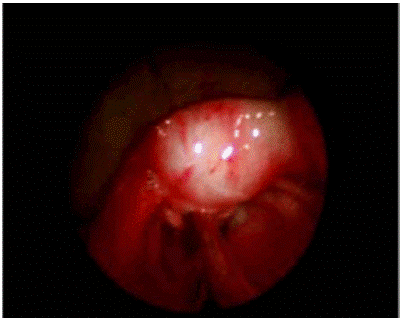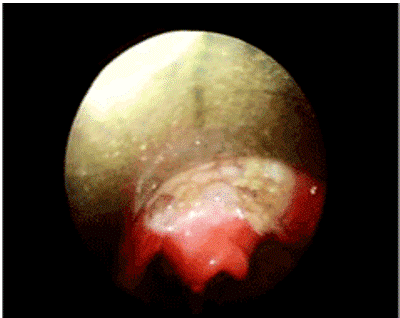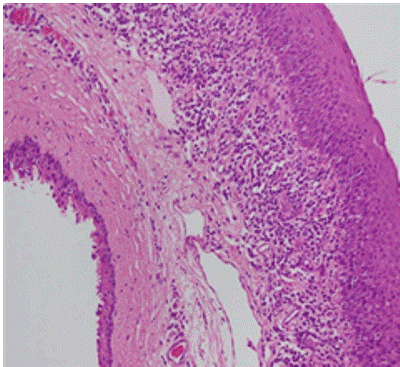A New Technique of Coblation used in 42 Infants with Epiglottic Cyst
Received: 17-Jun-2013 / Accepted Date: 24-Jun-2013 / Published Date: 01-Jul-2013 DOI: 10.4172/2161-119X.1000135
Abstract
Objective: The objective of this study is to investigate the safety and effectiveness of a new minimally invasive technique of coblation used in infants with epiglottic cyst.
Methods: 42 consecutive patients with epiglottic cyst underwent surgery by use ArthroCare ENT Coblator II Surgery System.
Results: All patients, including 29 males and 13 females, ranging in age from 1week to 4 years when surgery. All these patients recovered with no complications and was discharged from hospital in 7 days after surgery, no perioperative bleeding noted in any patient. The postoperative follow-up period ranged from 6 to 60 months, no recurrence was found during the follow-up examinations.
Conclusion: Use ArthroCare ENT Coblator II Surgery System for treatment of infant epiglottic cysts is simple, safe, and effective.
Keywords: Infant, Epiglottic cyst, Coblation
253791Introduction
Infant epiglottic cyst is uncommon but can interfere with feeding and breathing, leading to apnea, cyanosis, and other serious complications. We use a minimally invasive coblation technique for the resection of infant epiglottic cysts by ArthroCare ENT Coblator II Surgery System with successful results in 42 patients.
Patients and Methods
Between January 2008 to January 2011, 42 patients with epiglottic cyst were enrolled, including 29 males and 13 females, ranging in age from 1week to 4years when surgery. All patients removed the cyst by use the ArthroCare ENT Coblator II Surgery System, COBLATE setting of 6 and COAG setting of 3.
Results
All patients, including 29 males and 13 females, ranging in age from 1week to 4 years when surgery. All these patients recovered with no complications and was discharged from hospital in 7 days after surgery, the average length of hospital stay is 5.4 days, 32 patients tracheal extubation was made in the operating room 30-120 min after the end of the operation, the other 10 patients tracheal extubation was made in 4 h to 48 h after the end of the operation in the Intensive Care Unit. No perioperative bleeding noted in any patient. The postoperative followup period ranged from 6 to 60 months, no recurrence was found during the follow-up examinations.
Case Report
A 2750 g male infant was born at 40 weeks, delivered by natural labor, was diagnosed with congenital laryngeal stridor. There was evidence of respiratory distress and severe upper airway obstruction and often vomited when feed milk. Direct laryngoscopy revealed a white smooth surface cystic mass filling the oropharynx, therefore not being able to see any part of the vocal cords and the exact site of origin could not be well delineated. Then the pediatrician contact with the ENT department for further management. The surgery was performed at seven days after born. Before the operation, the infant was evaluated for operative contraindications. Following general anesthesia by tracheal intubation, the anesthetist managed to move the mass out of the way and intubate orally and stabilize the airway. We used suspension laryngoscopes to expose the cyst (Figure 1), and then removed the cyst with the ArthroCare ENT Coblator II Surgery System (Figure 2), COBLATE setting of 6 and COAG setting of 3. Operation time was approximately 10 minutes, and there was only about 0.1 ml of hemorrhage. The operation was successful and without any complications. Seven days after surgery, histological examination showed soft tissue lined by squamous epithelium, consistent with an epiglottic cyst (Figure 3). The patient recovered with no intervening complications and was discharged from hospital 6days after surgery. At follow-up examination, 6 month post excision, no evidence of a recurrence was noted.
Discussion
Epiglottic cyst refers to any cystic lesion on the epiglottis. Epiglottic cysts are thought to be caused by ductal obstruction. In 1984, Newman et al. found that most infants with epiglottic cyst develop symptoms during the first week of life [1-4]. The patients were born with laryngeal stridor and inspiratory dyspnea, smooth-surfaced cystic mass on the epiglottic vallecula by direct laryngoscopy. Cervical region lateral X-ray, ultrasound computed tomography, or magnetic resonance imaging may all be useful for estimating the size and location of the cyst [5-7]. Detailed physical examinations, including close observation of breathing patterns, may indicate upper-airway obstruction. If suspected, direct laryngoscopy or electron laryngoscopy performed with close monitoring of the patient’s breathing pattern provides a safe yet fast and effective diagnosis before surgery. The infant respiratory tract is small in diameter, so an epiglottic cyst can easily obstruct the airway, causing progressive inspiratory dyspnea and may even become life threatening. If the patient has feeding problems, inspiratory dyspnea, or fails to thrive, we suggest surgical intervention as early as possible.
In the past 30 years, many methods for removing epiglottic cysts have been developed, but there were no studies about use the ArthroCare ENT Coblator II Surgery System for this purpose [8,9]. Coblation is a unique modality that can ablate tissue by generating a field of ionized sodium molecules. During coblation, conductive saline solution is converted to an ionized plasma layer in the gap between the device tip and the tissue. Wherever this plasma layer meets the tissue, there is adequate energy to break molecular bonds, resulting in molecular dissociation. This effect is achieved at temperatures of approximately 40-70°C, so thermal damage to surround healthy tissue is minimized [10]. Use the minimally invasive technology of coblation during the operation of infant epiglottis cyst can cause less bleeding, little injury and postoperative organization reaction, thus effectively helps to solve the problem of bleeding and postoperative decannulation, This technique has the potential to serve as the treatment of choice in management of this condition.
Conclusion
Infant epiglottic cyst is uncommon but can interfere with feeding and breathing, leading to apnea, cyanosis, and other serious complications. The advantages of coblation excision include direct contact with the epiglottis cyst, improved targeting of cyst and preservation of normal tissue, and lower temperatures to prevent excessive burning, thus improve recovery time and minimize surgical and postsurgical complications, so is a simple, safe, and effective method.
References
- Pak MW, Woo JK, van Hasselt CA (1996) Congenital laryngeal cyst: current approach to management. J Laryngol Otol 110: 854-856.
- Mitchell DB, Irwin BC, Bailey CM, Evans JN(1987) Cysts of infant larynx. J Laryngol Otolaryngol 101: 833-837.
- Newman BH, Taxy JB, Laker HI (1984) Laryngeal cysts in adults: a clinic opathologic study of 20 cases. Am J Clin Pathol 81: 715-720
- Gutierrez JP, Berkowitz RG, Robertson CF (1999) Vallecular cysts in newborns and young infants. Pediatr Pulmonol 27: 282-285.
- Lee WS, Tsai CS, Lin CH, Lee CC, Hsu HT (2000) Airway obstruction caused by a congenital epiglottic cyst. IntJ Pediatr Otorhinolaryngol 53: 229-233.
- Dahm MC, Panning B, Lenarz T (1998) Acute apnea caused by an epiglottic cyst. Int J Pediatr Otorhinolaryngol 42: 271-276.
- Zawadzka-Glos L, Frackiewicz M, Brzewski M, Biejat A, Chmielik M (2009) Difficulties in diagnosis of laryngeal cysts in children. Int J Pediatr Otorhinolaryngol 73: 1729-1731.
- Nishimura B, Tabuchi K, Aoyagi Y, Tobita T, Wada T, et al. (2008) Epiglottic cyst in an infant. Auris Nasus Larynx. 35: 282-284.
- Wojnowski W, Pucher B, Grzegorowski M, Ryglewicz M (2006) Case reports of congenital laryngeal cysts in children .Otolaryngol Pol 60: 599-601.
- Chang KW (2005) Randomized controlled trial of Coblation versus electrocautery tonsillectomy Otolaryngol Head Neck Surg 132: 273-280.
Citation: Qiu S, Liu D, Huang Z, Zhong J (2013) A New Technique of Coblation used in 42 Infants with Epiglottic Cyst. Otolaryngology 3:135. DOI: 10.4172/2161-119X.1000135
Copyright: © 2013 Qiu S, et al. This is an open-access article distributed under the terms of the Creative Commons Attribution License, which permits unrestricted use, distribution, and reproduction in any medium, provided the original author and source are credited.
Share This Article
Recommended Journals
Open Access Journals
Article Tools
Article Usage
- Total views: 16702
- [From(publication date): 9-2013 - Mar 29, 2025]
- Breakdown by view type
- HTML page views: 12014
- PDF downloads: 4688



